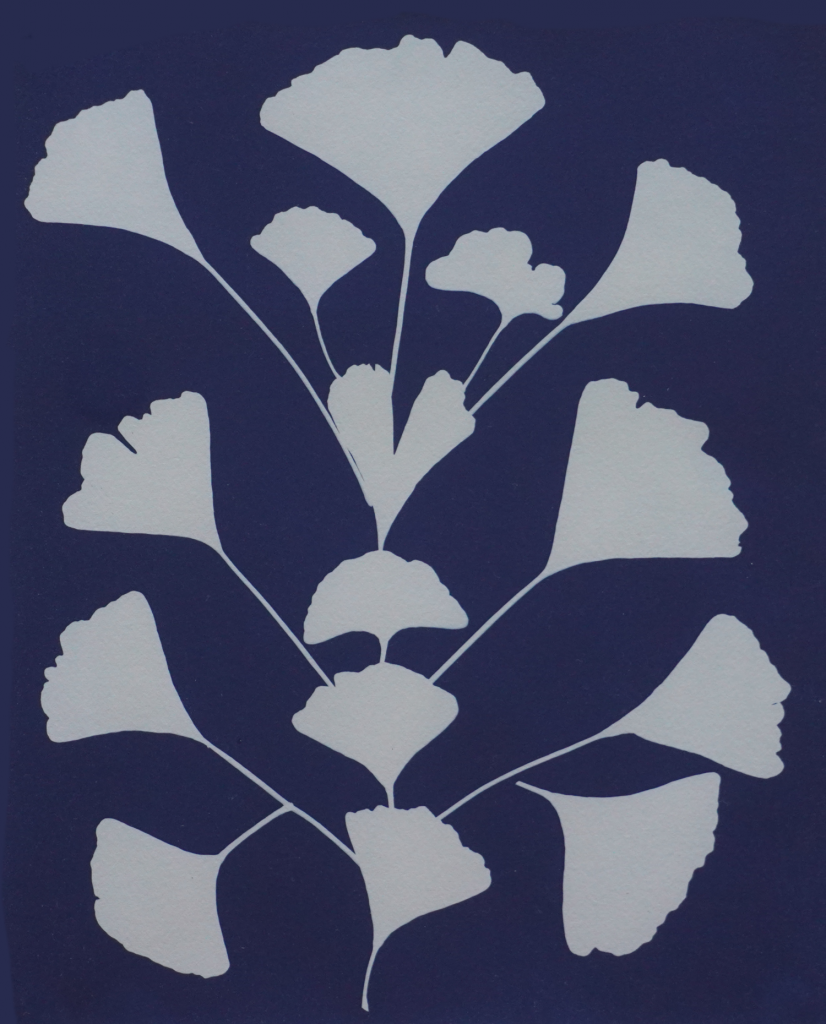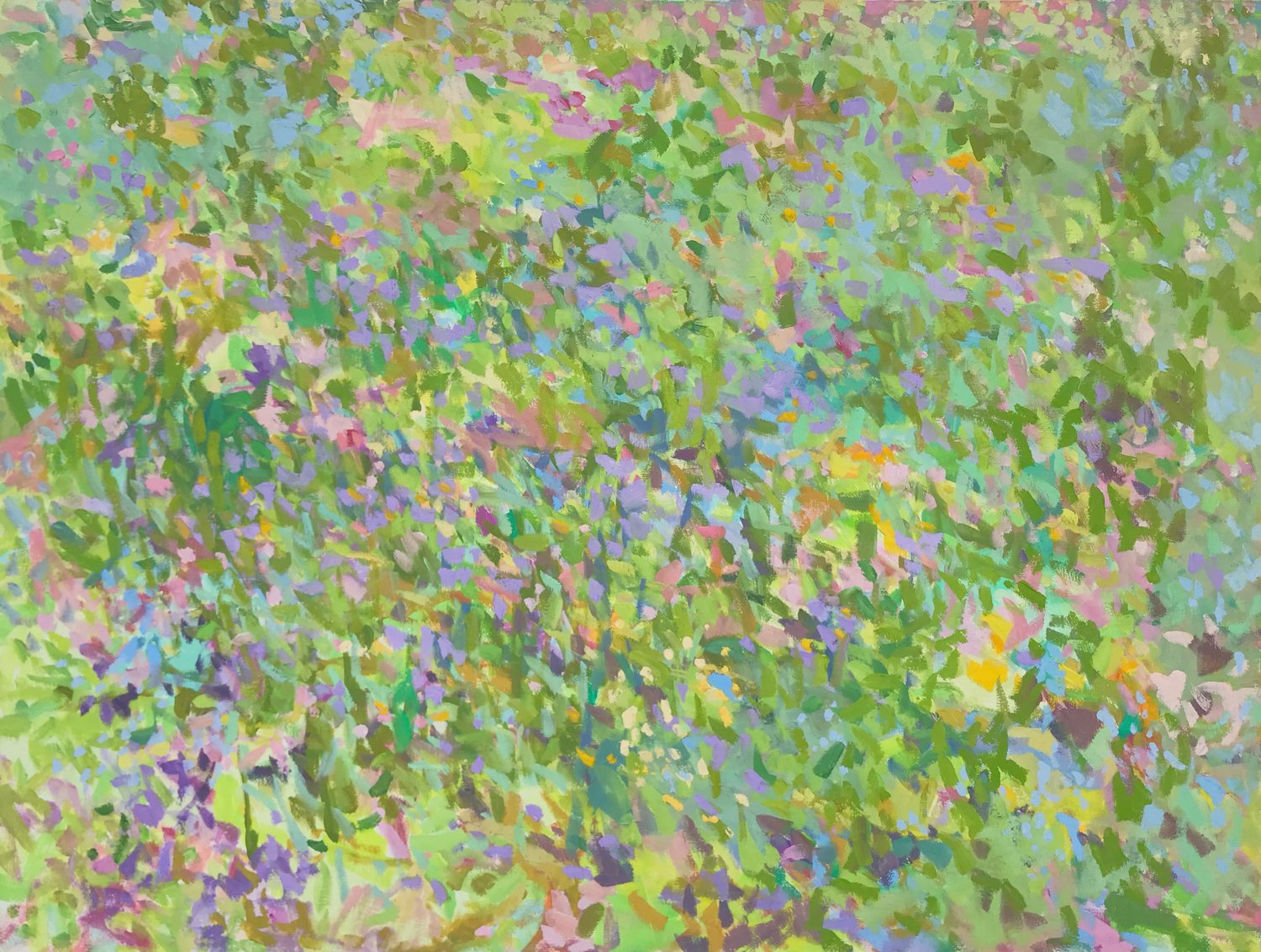As daily temps start to climb, and we await the vibrant colors of spring, Quirk Gallery offers a visually stunning show celebrating the work of two artists, Priscilla Whitlock and Mary Holland, whose work is guaranteed to lift winter’s gray grip.
Whether producing vignettes of her garden, open meadows, or mountain vistas, Whitlock’s “Eden” conveys with paint the essence of a place—not just its physical manifestation, but also the experience of being there. She clearly revels in depicting nature, and her manipulation of paint and her lively gestural style expose a deep appreciation for the purely visual aspects of painting, too.
The trio “Spring, Greens,” “Goldenrod Thistles” and “Wild Field, Mustard” are heady depictions of a world in full bloom. The paintings buzz with life. Whitlock captures the effects of nature—wind, shifting light and shadow, and the sense of ever-present insects—to reflect this bombinating sensation, but her painterly approach infuses the works with vitality. With “Spring, Greens,” Whitlock zooms in beyond the vegetation depicted in the other two works and emphasizes the riotous sensual quality of the place as a whole.
“Dogwoods, Spring Mountain” has an entirely different mood. Its muted colors suggest dawn or dusk, a quieter, more somber time. In the work, a vista of mountains rises above a grove of dogwood trees. The mountains are rendered in broad mauve and blue brushstrokes. Whitlock uses jagged lines to describe variations in the terrain, but for the most part this area has a distinct serenity as compared to the foreground. Visually, this situates the mountains in the distance, but it also fittingly depicts their grandeur and permanence. In front, the trees of the title are animated with wind and light. They seem to bend and twist before our eyes, brought to life by Whitlock’s adept handling of the paint.

With the showy “Bee Balm, My Garden” and “Blues, Pinks, Whites, My Garden,” Whitlock ventures closer to the world of abstract painting. Yes, these works are representations of plants in the patch of earth by her studio, but how she arranges her composition and the way she applies paint demonstrate an emphasis on the formal aspects of painting. Just look at the riotous blobs of pigment in “Blues, Pinks, Whites,” and the daubs of scarlet, green, and blue overlaid with the scrawl of oil stick in “Bee Balm.”
Like her paintings, Whitlock’s monotypes (unique images printed from a plate that has been painted by the artist) are about putting pigment down on a flat surface. These delightful, small-scale works possess a thrilling freshness and dynamism that holds its own against the larger works. “Flow,” “Spring, Peaches” and “Orchard, Spring” are visually striking examples, but I was particularly taken with the perfectly balanced “Water, Blues” and “My Garden.”
Whitlock has been producing monotypes for years. “I’ve stayed with it so long because it’s like playing another instrument,” she says. “You see something new that you wouldn’t have if you just stuck to your primary medium.”
At the other end of the gallery hangs Holland’s “Compositions in Blue: Cyanotype.” Cyanotype is a photographic printing process discovered in the mid-19th century that uses paper coated with a photo-sensitive solution and sunlight to produce an image of a stencil or object. The indigo hue produced by the cyanotype process has profound emotional resonance. Whether it strikes primordial chords within our subconscious, referencing natural phenomena like the night sky or deep water, this bold yet quiet color has an undeniably mysterious and romantic quality.
In 14 works, Holland takes full advantage of this. The reduced palette of blue and white sets off her striking arrangements of both natural and manufactured objects. Some of these she leaves as is. With others, she introduces collage and watercolor, occasionally adding the bling of silver foil to augment the white.
Holland’s assortments of leaves lend themselves well to the cyanotype technique. The veiny beech frond skeletons of “Forest Bathing,” the silvery disks of “Money Plant,” and the graphic power of the fan-shaped leaf blades in “Gingko Pattern,” all present a different kind of foliage. Holland’s approach reveals an affinity for the individual qualities of each specimen. With the first two, she employs collage to enhance the basic thrust of the work, adding silver to underscore the mica-like money plant pods and inserting silver hands in the allegorical “Forest Bathing.” When it comes to the distinctive gingko leaves, she adds nothing, deeming the rhythm of their silhouette powerful enough.
In other pieces, Holland turns to the world of handicrafts, using antique lace doilies, placemats, and embroidered handkerchiefs as her subjects. These are poetic works that highlight the intricacy of needlework and the filmy quality of fabric. Against the blue field, these stark white pieces are transformed to reveal works of intricate design and superb workmanship. One can’t help thinking about the anonymous creators of these bits of needlework.
“I think women’s work is undervalued,” says Holland. “Especially old crochet, and lace, and all these things women did. You can pick them up at junk shops and vintage places for very little, which is amazing when you think how beautiful they are and the amount of time that was put into them.” Holland gives these pieces a second chance and shines new light into their origins.
